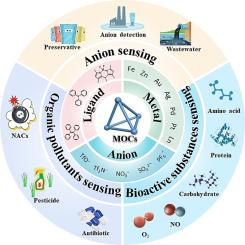Emerging fluorescent supramolecular metal-organic cages: structural chemistry and fluorescent sensing applications
IF 23.5
1区 化学
Q1 CHEMISTRY, INORGANIC & NUCLEAR
引用次数: 0
Abstract
Supramolecular metal-organic cages (MOCs) have demonstrated tremendous potential across diverse fields due to their unique structural designability and multifunctionality. Current research continues to explore and optimize their structural design and functional properties. This review focuses on the structure chemistry of MOCs based on various fluorescent ligands (e.g., TPE, BODIPY, TPA, etc.), elucidating the structure-property relationship between the structural characteristics of fluorescent MOCs and their photophysical behaviors. Additionally, we provide an overview of the role played by metal centers in these luminescent cages. Building upon the unique properties of fluorescent MOCs, we specifically highlight their applications in fluorescent sensing, including anion sensing, organic pollutant detection, and bioactive substance recognition. Finally, we outline current challenges and future directions in this field, offering new perspectives for designing high-performance fluorescent sensing materials.


新型荧光超分子金属有机笼:结构化学和荧光传感应用
超分子金属有机笼(MOCs)由于其独特的结构可设计性和多功能性,在各个领域显示出巨大的潜力。目前的研究仍在继续探索和优化它们的结构设计和功能特性。本文综述了基于各种荧光配体(如TPE、BODIPY、TPA等)的moc的结构化学,阐明了荧光moc的结构特征与其光物理行为之间的结构-性能关系。此外,我们还概述了金属中心在这些发光笼中所起的作用。基于荧光moc的独特性质,我们特别强调了它们在荧光传感方面的应用,包括阴离子传感、有机污染物检测和生物活性物质识别。最后,我们概述了该领域当前面临的挑战和未来的发展方向,为高性能荧光传感材料的设计提供了新的视角。
本文章由计算机程序翻译,如有差异,请以英文原文为准。
求助全文
约1分钟内获得全文
求助全文
来源期刊

Coordination Chemistry Reviews
化学-无机化学与核化学
CiteScore
34.30
自引率
5.30%
发文量
457
审稿时长
54 days
期刊介绍:
Coordination Chemistry Reviews offers rapid publication of review articles on current and significant topics in coordination chemistry, encompassing organometallic, supramolecular, theoretical, and bioinorganic chemistry. It also covers catalysis, materials chemistry, and metal-organic frameworks from a coordination chemistry perspective. Reviews summarize recent developments or discuss specific techniques, welcoming contributions from both established and emerging researchers.
The journal releases special issues on timely subjects, including those featuring contributions from specific regions or conferences. Occasional full-length book articles are also featured. Additionally, special volumes cover annual reviews of main group chemistry, transition metal group chemistry, and organometallic chemistry. These comprehensive reviews are vital resources for those engaged in coordination chemistry, further establishing Coordination Chemistry Reviews as a hub for insightful surveys in inorganic and physical inorganic chemistry.
 求助内容:
求助内容: 应助结果提醒方式:
应助结果提醒方式:


